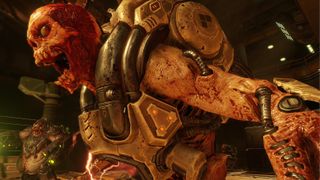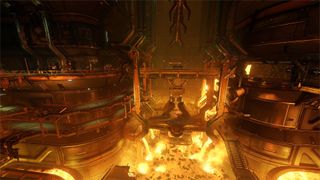Doom hands-on: teaching old demons new tricks

This article was originally published in PC Gamer issue 283. For more quality articles about all things PC gaming, you can subscribe now in the UK and the US.
Brad Bramlett, id’s multiplayer producer, describes it as “movement as defence.” Art director Hugo Martin says he wants players to feel like “Bruce Lee with a shotgun on a skateboard.” Marty Stratton, Doom’s executive producer, puts it more bluntly. “Stopping is death,” he told a crowd at 2015’s QuakeCon in Dallas, Texas. To encourage players to stay in motion, Doom has no regenerative health, no stealth system, and multiplayer matches that are all about capturing the devastating power-ups that are scattered throughout the arena.
"Doom is all about moving, and never standing still. Says Stratton: “it ties into every decision we make.”
How do you reboot a seminal PC classic like Doom, a game whose DNA is present in every shooter since 1993? For id, it’s a carefully considered process that avoids simple fan service in favour of new twists and takes on familiar material.
This is the main consideration when it comes “all that nostalgia stuff,” Stratton told me at QuakeCon. “We’re not putting things in the game just because they existed in the past. To the extent that we feel like something does belong in the game because of the game’s history, we’re making sure that it isn’t just in there to check the box. It’s in there with purpose.”
If you’ve played Doom before, there will be plenty of familiar sights, but Stratton wants to surprise veteran players just as much as those who may be trying a Doom game for the first time. Take the Revenant, a mainstay demon in the series. “If you know Doom, you know that’s the Revenant. If you don’t know Doom, he is totally cool and crazy. He’s a massive skeleton with a mechanised pack that shoots rockets from his shoulders... and he has a jetpack. He didn’t have a jetpack in Doom, so I think that’s a good example of ‘this is a Doom-now creature.’ If you know Doom you look back and you’re like, ‘Ahhh, I see what they did there’. He’s very new in his implementation.”

The same philosophy extends from the enemies to the weapons. While familiar guns like the super shotgun, plasma rifle and rocket launcher can be seen in the E3 trailer, they have new alt-fire features as well as weapon mods and attachments that can be collected in the campaign. id wants to drop in other familiar elements that longtime fans will recognise—the sound of the mechanical doors sliding open, for example, is carried over from the original—but they didn’t want to copy and paste every little detail. Just enough to ring an occasional bell. That includes the music. Doom’s soundtrack is one of the most recognisable in gaming history, but it hasn’t been entirely recreated note for note for the new game. “It’s not like we’ve taken songs and just said, oh, let’s redo that,” Stratton says. But there will be moments of music that returning players will recognise. “We’ll weave little elements in there once in a while.”
The biggest gaming news, reviews and hardware deals
Keep up to date with the most important stories and the best deals, as picked by the PC Gamer team.
There are plenty of completely new features as well, most notably the ultra-bloody melee finishing moves, or ‘glory kills’ as they’re referred to by id’s staff. When players push in close to enemies they’ll be able to tear off a monster’s leg and jam it into its skull, yank a demon’s jaws apart with both hands, or rip out the heart of a Mancubus and cram it down its throat.
Even with these gruesome acts, movement is an important consideration. The kills are dynamic, and the resulting animation depends on which part of the demon’s body you focus on. But it was also important that glory kills were lightning fast. Says Robert Duffy, id Software’s chief technology officer: “You don’t want to feel like control is ever taken from you, and very early on we determined that 600-700 milliseconds is about the time that you have to start and finish... And so I think it really played well into the speed of the game.” Glory kills will also provide a greater health pickup than players would get from killing enemies with a weapon.

Chris started playing PC games in the 1980s, started writing about them in the early 2000s, and (finally) started getting paid to write about them in the late 2000s. Following a few years as a regular freelancer, PC Gamer hired him in 2014, probably so he'd stop emailing them asking for more work. Chris has a love-hate relationship with survival games and an unhealthy fascination with the inner lives of NPCs. He's also a fan of offbeat simulation games, mods, and ignoring storylines in RPGs so he can make up his own.
Most Popular

